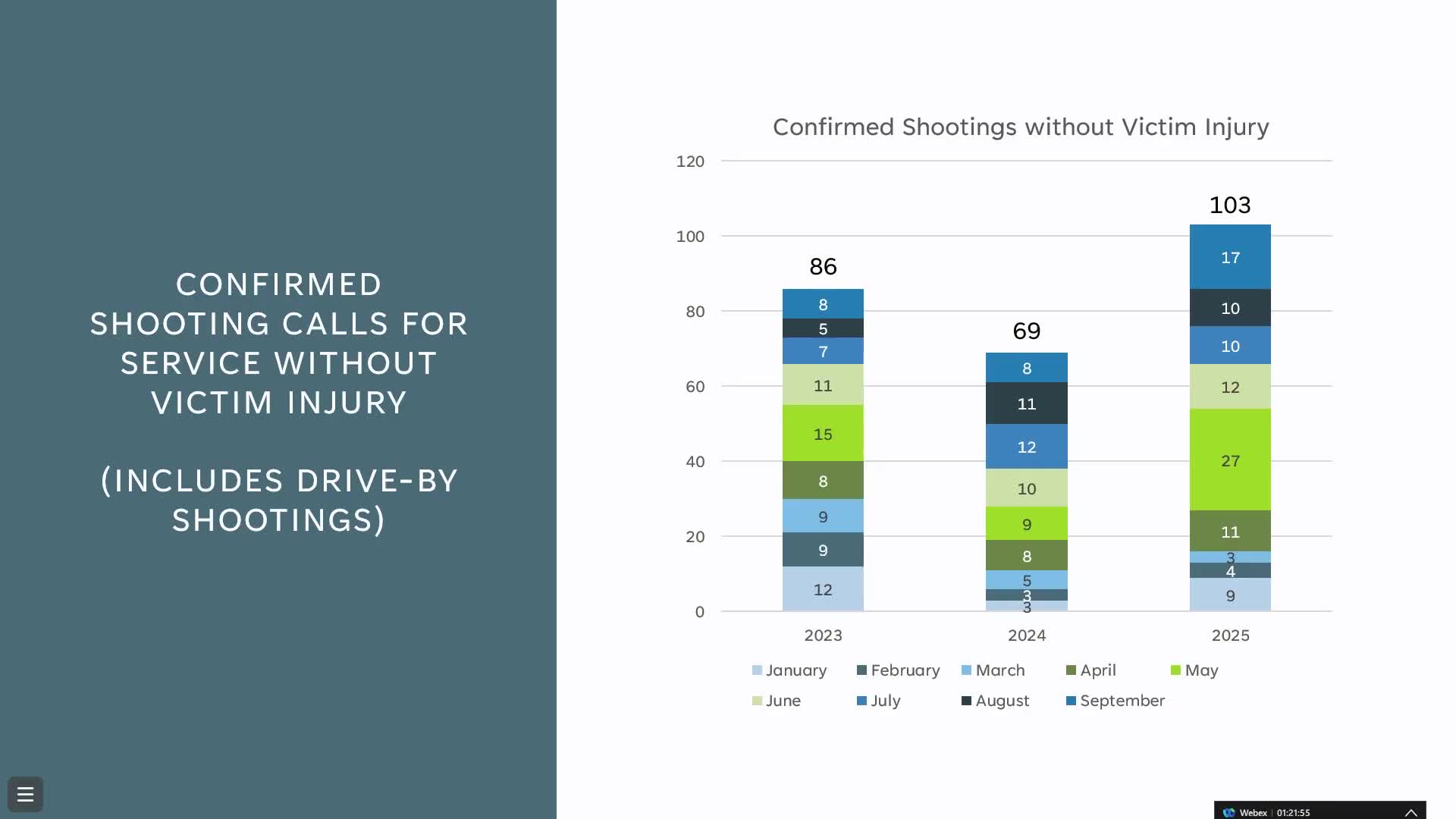Police report: shootings and NIBIN analysis rise; chief seeks citywide fix to 'home' ordinance
October 06, 2025 | Spokane, Spokane County, Washington
This article was created by AI summarizing key points discussed. AI makes mistakes, so for full details and context, please refer to the video of the full meeting. Please report any errors so we can fix them. Report an error »

Police Chief Adam Hall told the Spokane City Public Safety Committee on Oct. 6 that confirmed shooting calls without injury are “tracking up” this year even as confirmed shootings with injury were down from previous years, and that the department has installed a NIBIN (National Integrated Ballistic Information Network) machine to speed ballistic linkage.
“NIBIN stands for National Integrated Ballistic Information Network. It's managed by the ATF,” Hall said, explaining that the local NIBIN machine creates 3‑D images of cartridge casings and firing‑pin marks to match firearms across incidents and reduce the months‑long backlog previously sent to the state lab.
Hall briefed the committee on a series of operational metrics: 911 calls continued to fall while crime‑check (311) and officer‑initiated calls rose; crimes against persons (driven by assaults) were largely flat year‑to‑date; property crime continued to decline; and drug and trespass arrests remained concentrated in the downtown core. He said the department is building a data pipeline to speed and standardize shooting counts.
Staffing and patrol changes: Hall said the department moved to a three‑shift model immediately and will adopt a four‑shift model in January to better match coverage to demand and give officers predictable time off. He said patrol strength was reflected in a total of 144 officers currently assigned to patrol and that shift design and precinct combinations were adjusted after a workload analysis.
Home ordinance review: Hall and administration staff told the committee that they intend to propose modifications to the city’s obstruction and unlawful‑camping ordinance so the city can address problem behaviors “without any geographic or time restrictions” and use triage resources such as the Cannon Street shelter or a crisis stabilization facility as places officers can direct people. Hall said the city is formalizing a “high utilizer” list and a reserve‑bed pilot with partners to identify the county’s top 10 highest consumers of emergency services and provide immediate engagement and warm handoffs from jail to community treatment when appropriate.
Council reaction: members pressed for specifics about proposed changes, timelines for a public process and whether council would receive drafts in advance. Several councilmembers urged citywide application of any amended ordinance and clearer enforcement tools that target behavior rather than housing status. Some members asked for an emergency ordinance option to speed fixes; others cautioned against rushing without necessary service capacity in place.
Ending: Hall said the administration will circulate an overarching strategy and expects to take input from business owners, community groups and council before finalizing language. He described the changes as tactical and behavior‑focused, aimed at chronic offenders and high‑consumption behavior downtown while improving options for navigation and diversion to services.
“NIBIN stands for National Integrated Ballistic Information Network. It's managed by the ATF,” Hall said, explaining that the local NIBIN machine creates 3‑D images of cartridge casings and firing‑pin marks to match firearms across incidents and reduce the months‑long backlog previously sent to the state lab.
Hall briefed the committee on a series of operational metrics: 911 calls continued to fall while crime‑check (311) and officer‑initiated calls rose; crimes against persons (driven by assaults) were largely flat year‑to‑date; property crime continued to decline; and drug and trespass arrests remained concentrated in the downtown core. He said the department is building a data pipeline to speed and standardize shooting counts.
Staffing and patrol changes: Hall said the department moved to a three‑shift model immediately and will adopt a four‑shift model in January to better match coverage to demand and give officers predictable time off. He said patrol strength was reflected in a total of 144 officers currently assigned to patrol and that shift design and precinct combinations were adjusted after a workload analysis.
Home ordinance review: Hall and administration staff told the committee that they intend to propose modifications to the city’s obstruction and unlawful‑camping ordinance so the city can address problem behaviors “without any geographic or time restrictions” and use triage resources such as the Cannon Street shelter or a crisis stabilization facility as places officers can direct people. Hall said the city is formalizing a “high utilizer” list and a reserve‑bed pilot with partners to identify the county’s top 10 highest consumers of emergency services and provide immediate engagement and warm handoffs from jail to community treatment when appropriate.
Council reaction: members pressed for specifics about proposed changes, timelines for a public process and whether council would receive drafts in advance. Several councilmembers urged citywide application of any amended ordinance and clearer enforcement tools that target behavior rather than housing status. Some members asked for an emergency ordinance option to speed fixes; others cautioned against rushing without necessary service capacity in place.
Ending: Hall said the administration will circulate an overarching strategy and expects to take input from business owners, community groups and council before finalizing language. He described the changes as tactical and behavior‑focused, aimed at chronic offenders and high‑consumption behavior downtown while improving options for navigation and diversion to services.
View full meeting
This article is based on a recent meeting—watch the full video and explore the complete transcript for deeper insights into the discussion.
View full meeting
